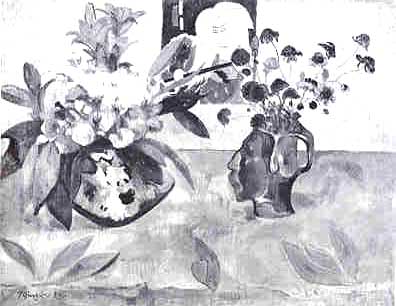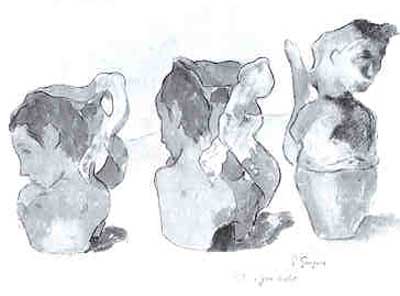Presentation for chapters 4, 5, and 6 By Jason Zollinger
|
||
| According to this article, Paul Gauguin originally had no intention of becoming a fine artist. He spent time in the Navy, lived as a family man and pursued a career in finance. It seems a change came about in his life when he came to have association with one TheoVan Gogh, an art dealer who eventualy put Gauguin in connection with his brother, Vincent. It is also written that at one point Vincent Van Gogh and Paul Gauguin were locked in a heated argument which led to or perhaps triggered Vincent's self-amputation of his ear. It is mentioned in this article that as a ceramist, Gauguins' work is greatly underappreciated. It is noteworthy, however, that when the great Pablo Picasso studied in France, his first artist-mentor, Francisco Durrio, exposed Picasso to Paul Gauguin's ceramics which were--and still are-- greatly underappreciated. Despite a downgrading of ceramics as an art form in the 19th century, Picasso saw how a "minor" material like clay could be turned to greatly expressive and highly aesthetic ends. |
||
|
Image of a Ceramic Sculpture This image shows a conceptual representation of one of Gauguin's sculptures. It is formed in the image of a vase or flower pot with a handle and displays the form of a face on the front side. |
 |
|
| |
The Ceramic Vase I have not been able to discover the name of this piece if there is one. Here we see the sculpture in it's final incarnation. An impressive ceramic vase that can be used for holding flowers or will complement a room on it's own. |
|
 |
A More Refined Example Here is a more developed example of Paul Gauguin's ceramic work. This appears to be another conceptual representation of a vase or pitcher sculpture showing the face/bust of a woman. There are three different angles shown, giving the viewer an idea of what the sculpture will look like from different viewpoints. |
|
The Final Piece The final piece is a wonderful example of Paul Gauguin's sculpting capability. It is a beautiful artifact depicting the shape of a woman looking out of the piece. The opposite side is decorated with shapes and designs that appear to look like birds. During the course of it's creation, Gauguin painted the artifact with bright and expressive colors |
||
I feel that these examples demonstrate Paul Gauguin's proficiency as a sculptor. I find it admirable that he would choose to find expression and meaning in a form of art during a time that it was not considered a popular medium for artwork. Not only did he achieve such expression, he did it with the precision and quality that only a good artist could produce. I am intrigued and have respect for his work.
|
||